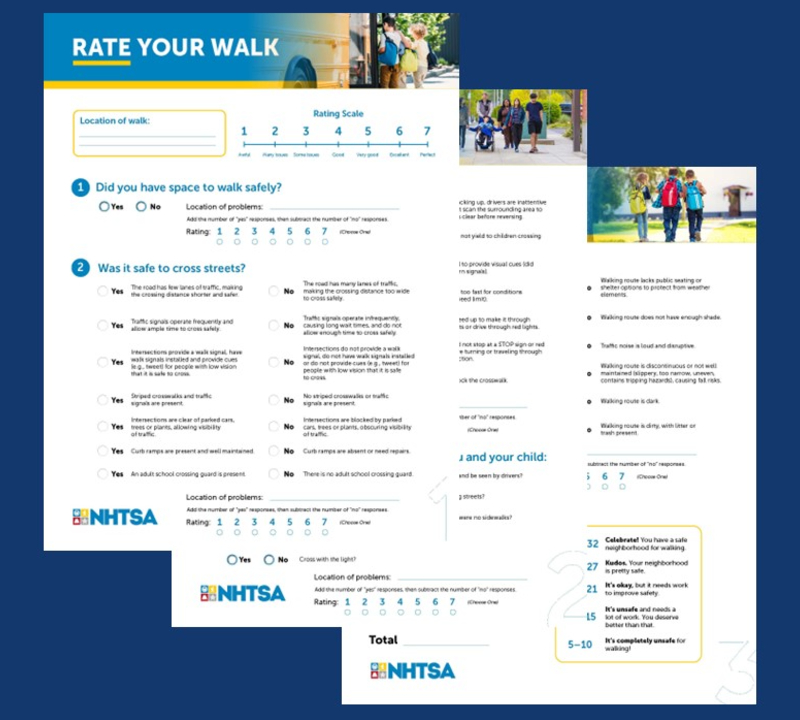
Walkability Checklist Guide
Overview
How safe and walkable are the routes you and your children take? Take a walk with your children, friends or family and complete the walkability checklist.
Getting Started
- Review the checklist available on this webpage.
- Take a walk as a family or as a group to assess your community.
- Determine what type of assessment you want to do — a single location (e.g., at a school), or a walking assessment (routes to and from school).
- Determine who should participate in the walk — schools, youth, community members, law enforcement, 911 and EMS, business owners, other road users, local officials, etc.
- Choose a date and time — if the walk is near a school, then weekdays and timing should be associated with school openings and closings. Weather always plays a factor in the number of walkers, so season might be key as well.
- Observe who else is using the walkway. Take photos to show both safe and unsafe features on your walk. You can share these with local officials along with the results.
- Get access to local pedestrian crash data through your local government or use NHTSA’s Pedestrian Safety Data Visualization Tool to see a snapshot of the issues that face your state and community.
After you've rated your walk and identified any problem areas, the next step is to figure out what you can do to improve your community's score. You'll find both immediate answers and long-term solutions under the Improving Walkability section.
Checklist
Improving Walkability
1. Did you have room to walk safely?
Common Issues
- Sidewalk gaps or paths that started and stopped.
- Broken or cracked sidewalks.
- Sidewalks blocked.
- No sidewalks, paths or shoulders.
- Cars felt too close to safely cross.
- Invite local leaders and decision-makers to join you for a walk.
- Tell your local department of transportation and law enforcement agency about specific problems, or send an email and provide a copy of the checklist.
- Work with park or recreation agencies to have trails through parks.
- Advocate for change by getting others involved, petitioning, or speaking up at community meetings.
- Work with a local transportation engineer to develop a plan for a safe walking route.
- Collaborate with law enforcement to design an enforcement effort.
2. Was it safe to cross streets?
Common Issues
- Road too wide to cross safely.
- Traffic signals made us wait too long or did not give us enough time to cross.
- Crosswalks/traffic signals needed.
- View of traffic blocked by parked cars, trees, or plants.
- Curb ramps or curb ramp repairs needed.
- Share problems and checklist results with local department of transportation and law enforcement.
- Trim your trees or bushes that block the street, and ask your neighbors to do the same.
- Look all directions before stepping into the street.
- Make eye contact with the driver before crossing.
- Advocate for change by getting others involved, petitioning, or speaking up at community meetings.
- Work with a local transportation engineer to develop a plan for a safe walking route.
- Collaborate with law enforcement to design an enforcement effort.
3. Did you feel safe walking around vehicle traffic?
Common Issues
- Drivers backed without looking.
- Drivers did not yield.
- Drivers turned into pedestrians without looking.
- Driver drove too fast.
- Drivers sped up to make traffic lights or drove through red lights.
- Set an example by slowing down and being considerate of others.
- Encourage your neighbors to do the same.
- Report hazardous driving behaviors to law enforcement.
- Implement quick build solutions (bulb-outs or curb extensions, road diets, etc.)
- Request protected turns.
- Ask city planners and traffic engineers for low-cost traffic calming ideas.
- Ask schools about getting adult crossing guards at key locations.
- Organize a neighborhood speed watch program.
- Collaborate with law enforcement to design an enforcement effort.
4. Could you follow safety rules and laws?
Common Issues
- Cross at crosswalks or where you can see and be seen.
- Stop and look left, right, left before crossing.
- Walk on sidewalks, or shoulders facing traffic.
- Cross with the traffic signal.
- Educate yourself and your children about safe walking behaviors.
- Organize parents in your neighborhood to walk children to school, also known as a walking school bus.
- Use NHTSA’s toolkit on Planning School Bus Stops and Routes for safety.
- Encourage schools to teach walking safely at all ages.
- Help schools start safe walking programs.
- Enlist school resource officer participation.
5. Did your walk feel safe? If not, why?
Common Issues
- No streetscape features (lack of seating or shelter from the elements).
- Not enough shade.
- Traffic noise.
- Risk of falls — sidewalks not maintained/cleared during snow events.
- Sidewalks slippery or designed poorly (too narrow, long gaps between, etc.).
- Uneven sidewalks (tree roots or cracks in sidewalks created a tripping hazard).
- Not well lighted.
- Dirty, lots of litter or trash.
- Start a pedestrian safety coalition including community leaders, elected officials, planners, engineers, departments of public works, schools, youth, EMS and local law enforcement.
- Ask city planners and traffic engineers how the sidewalks and paths can be better maintained.
- Get local media to do a story about pedestrian safety around school zones.
- Call the parks and recreation department about community walks.
- Encourage local support for walking programs.
- Seek permission to plant shade trees along routes.
Resources
Federal Government
- National Highway Traffic Safety Administration | Pedestrian Safety | School Bus Safety
- Traffic Safety Marketing | Pedestrian Safety | School Bus Safety
- Federal Highway Administration | Pedestrian & Bicycle Safety
- U.S. Access Board
National Organizations

